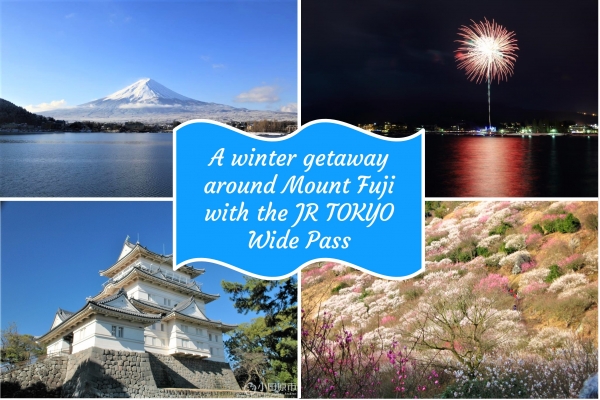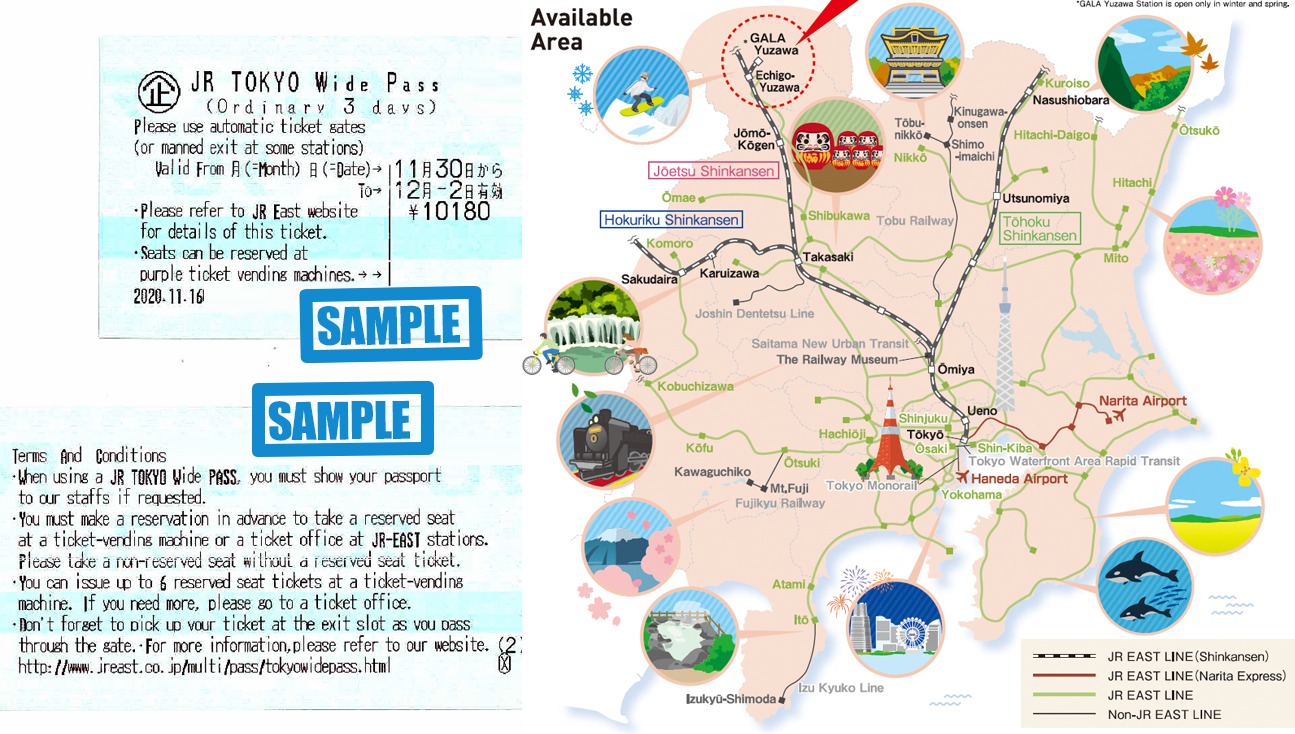A winter getaway around Mount Fuji with the JR TOKYO Wide Pass

Mount Fuji (富士山 Fuji-san) is one of the most famous landmarks in Japan, and is perhaps the most recognised mountain in the country. Getting a good view of it takes only a short train trip from Tokyo, and many visitors make a trip to around the mountain to visit major attractions such as the picturesque Lake Kawaguchiko (河口湖) and Lake Yamanakako (山中湖).
Many people would think that the best time to visit Mount Fuji is in the summer because it’s the mountain climbing season. But do you know that the mountain is especially beautiful to see in winter? For this article, we will be exploring the amazing things that visitors can experience around Mount Fuji for the winter season, including amazing viewpoints of the mountain, eye-catching fireworks, and magnificent winter sights that most people would not expect.

Map of Mount Fuji’s surrounding areas. (Image credit: Google Maps)
Plus, for our journey, we shall be using the JR TOKYO Wide Pass, which enables us to visit all kinds of exciting places in 3 days and see why winter is an ideal time to travel around the Tokyo region for a short yet unforgettable winter journey. So put on your winter jackets and let’s embark on an eye-opening winter adventure around Tokyo!
Day 1: Lake Kawaguchiko & Lake Yamanakako
The E353 series train used for the Limited Express Fuji Excursion. (Image credit: JR East)
What makes travelling around Tokyo enjoyable is the sheer railway connectivity that enables travellers to embark from Tokyo and head to places around the region easily. For instance, with the JR TOKYO Wide Pass, they can begin their journey from JR Shinjuku Station (JR新宿駅) and hop on the Limited Express Fuji Excursion (富士回遊 Fuji Kaiyū) to reach the area around Mount Fuji. With this train, travellers can do so in less than 2 hours!
① See Mount Fuji from high above

View of Mount Fuji from Lake Kawaguchiko during winter. (Image credit: やまなし観光推進機構)
With its iconic snow-capped façade and beautifully symmetrical shape, Mount Fuji is a must-see landmark for both local and foreign visitors who are based in Tokyo, and is also famous among mountain climbers, especially during the summer. Plus, with its sheer grand scale, the mountain can be seen from many viewpoints from surrounding regions, and on clear days, it can be seen from as far as Chiba Prefecture (千葉県)!
For our first stop, we make our way to Lake Kawaguchiko, the second-largest among the famous Fuji Five Lakes (富士五湖 Fuji-goko) that is known to have one of the best views of Mount Fuji. There are many spots around the lake that offer splendid views of Mount Fuji, but first, let’s start with one high in the sky!
Access to Lake Kawaguchiko
Take a 115-minute train ride from JR Shinjuku Station to Fujikyuko Line Kawaguchiko Station (富士急行線 河口湖駅). From there, take the Fujikyuko Kawaguchiko Sightseeing Bus (Red Line) to Lake Kawaguchiko. The bus journey takes between 5 to 20 minutes, depending on your preferred alighting destination around the lake.

Riding the Mt. Fuji Panoramic Ropeway. (Image credit: Stephen Spencer / CC BY-NC-SA 2.0)
One of the most popular ways to enjoy a view of Mount Fuji is to take the Mt. Fuji Panoramic Ropeway (previously known as Kachi Kachi Ropeway). Located on the eastern side of Lake Kawaguchiko, the ropeway allows visitors to go up 400m to an observation deck that offers a breathtaking panoramic view of the lake below with the mountain in the far distance.

Mount Fuji seen from the observation deck. (Image credit: やまなし観光推進機構)
And here’s a fun fact for you: do you know that winter is the best time to see Mount Fuji? That’s because the air is drier especially in January and February compared to other months, which makes Mount Fuji much more visible even from faraway locations. In the summer however, the mountain is often invisible on many days because the weather around it is often hazy due to humidity.
Mt. Fuji Panoramic Ropeway (富士山パノラマロープウェイ)
Address: 1163-1 Azagawa, Fujikawaguchiko Town, Minamitsuru District, Yamanashi 401-0303
Nearest station: 10-minute bus ride from Kawaguchiko Station
Operating hours:
9:30am–4pm (weekdays, last descent at 4:20pm)
9:30am–5pm (weekends and holidays, last descent at 5:20pm)
Admission fees: ¥500 per one way, ¥900 per round trip
② See Mount Fuji from around Lake Kawaguchiko

Views of Mount Fuji from Nagasaki Park (top), Ōike Park (bottom right), and Ōishi Park (bottom left). (Image credit: Kawaguchiko.net (top), photoAC (bottom))
Lake Kawaguchiko is often regarded as one of the best places to view Mount Fuji, and it’s not only because of the lake’s geographic location and proximity to the mountain. It’s also because of its elevation: among the Fuji Five Lakes, it has the lowest elevation of them all. This offers visitors an elevated view of the mountain, making it look even more imposing in grandeur and scale.

Map of Lake Kawaguchiko. (Image credit: Google Maps)
After our ride on the ropeway, we can make our way down and explore viewpoints of Mount Fuji around the lake. Visitors can hop on the Fujikyuko local bus and visit popular spots such as Ōishi Park (大石公園), Nagasaki Park (長崎公園), and Ōike Park (大池公園). Here's a tip for all visitors: the best scenery is from the northern side of the shore i.e. Oishi Park and Nagasaki Park, where visitors can capture a view of the mountain together with the lake.
③ Witness a “diamond” in the sky

Lake Yamanakako in winter, with Mount Fuji in the background. (Image credit: やまなし観光推進機構)
Lake Yamanakako is the largest lake among the Fuji Five Lakes, and the one closest to Mount Fuji. It is also one with the highest elevation among the Fuji Five Lakes with an elevation of 982m above sea level. After visiting Lake Kawaguchiko, we head on over to this lake where a big surprise awaits.

“Diamond Fuji” seen from Lake Yamanakako. (Image credit: やまなし観光推進機構)
Under the right circumstances, lucky visitors at Lake Yamanakako are able to see a phenomenon known as “Diamond Fuji” (ダイアモンド富士) when the sun overlaps the peak of Mount Fuji, thus resembling a shining diamond in the sky. This view can be seen during sunrise and sunset at other locations, but since Lake Yamanakako is located on the eastern side of Mount Fuji, it can be observed only during sunset.

A crowd of photography enthusiasts catching the view of “Diamond Fuji”. (Image credit: やまなし観光推進機構)
Furthermore, “Diamond Fuji” can be seen and enjoyed at Lake Yamanakako over an extended period, from October to February, with the timing that varies according to the exact period. It can be seen sometime around 3:30pm near the winter solstice (around 22 December), and around 4:30pm in mid-October and late February.
What makes the sight at this lake particularly captivating is the “mirror effect” that takes place when the view is reflected on the lake’s clear water. The magnificent view has since attracted throngs of photography enthusiasts to Lake Yamanakako to capture the scenery for themselves.

Map of Lake Yamanakako. (Image credit: Google Maps)
There are a total of nine spots where people can have a scenic view of “Diamond Fuji”, including the ones below that are around Lake Yamanakako:
- Panorama Observatory (パノラマ台)
- Asahigaoka Lakeside (旭日丘湖畔緑地公園)
- Hirano Lakefront (平野湖畔)
- Nagaike Water Park (長池親水公園)
- Hana no Miyako Flower Park (花の都公園)
“Diamond Fuji” at Lake Yamanakako. (Video credit: 山中湖村観光課)
Access to Lake Yamanakako
Take the Fujikyuko local bus on the Fujikko-go Line (F Line) from Kawaguchiko Station to the Hotel Mount Fuji Iriguchi (ホテルマウント富士入口) bus stop. The bus departs hourly, and the journey takes around 25 minutes.
④ Enjoy spectacular winter lights and fireworks

Yamanakako Ice Candles Festival. (Image credit: やまなし観光推進機構)
When night falls, visitors to Lake Yamanakako will be able to witness the Yamanakako Ice Candles Festival (山中湖アイスキャンドルフェスティバル), where candles made from ice are lined up on the ground and fireworks are launched against the Mount Fuji backdrop. It’s an event that visitors should not miss, and the view of the candle lights on the snowy white ground with fireworks in the sky is something they have to see for themselves.
Yamanakako Ice Candles Festival (山中湖アイスキャンドルフェスティバル)
Date: *22 February 2022 (National Foundation Day)
Time: 4pm–7pm (candle lighting from 4:30pm onwards, fireworks at 6pm)
Venue: Yamanakako Communication Plaza KIRARA (山中湖交流プラザ きらら)
Access: 1-hour bus ride from Kawaguchiko Station or 15-minute bus ride from Hotel Mount Fuji Iriguchi bus stop
Ticket prices: Free
*Date may vary according to the year.
**Due to the ongoing coronavirus pandemic, the contents of the program may change without prior notice.

Winter fireworks at Lake Kawaguchiko at night. (Image credit: photoAC)
After our visit to Lake Yamanakako, we return to Lake Kawaguchiko to take part in a larger-than-life spectacle. When night falls, visitors to the lake can experience the Lake Kawaguchiko Winter Fireworks (河口湖冬花火), an annual winter event where spectators will get to see colourful fireworks in the clear night sky against the Mount Fuji backdrop.
The fireworks are launched from various points around the lake such as Ōike Park, Yagisaki Park (八木崎公園), and Tatamiiwa (畳岩), so they can be seen from several locations around the lake. What’s more, visitors who are staying at the hotels around the lake can witness the spectacle too, making for an unforgettable lodging experience.
Lake Kawaguchiko Winter Fireworks (河口湖冬花火)
Dates: *22 January–20 February (Saturdays and Sundays only) & 23 February (Mount Fuji Day)
Time: 8pm–8:20pm
Recommended venues: Ōike Park (main venue) and Yagisaki Park
Access:
Ōike Park: 15-minute walk from Kawaguchiko Station
Yagisaki Park: 30-minute walk from Kawaguchiko Station
Ticket prices: Free
*Dates may vary according to the year.
**Due to the ongoing coronavirus pandemic, visitors who are staying at hotels around Lake Kawaguchiko are encouraged to view the fireworks from their accommodations.

Winter Tanabata Festival at Lake Kawaguchiko. (Image credit: やまなし観光推進機構)
You may have heard of the Sendai Tanabata Festival (仙台七夕まつり Sendai Tanabata-matsuri), the largest summer festival in Japan. But have you heard of the Winter Tanabata Festival (冬の七夕まつり Fuyu no Tanabata matsuri)? In winter, bamboo decorations are put up at Ōishi Park and they are lit up when night falls. Plus, a 3m-high waterfall illumination named the Niagara Light & Wave (光のナイアガラ&ウェイブ) will be installed along the riverside for spectators to marvel at. Don’t miss this sight if you’re watching the fireworks from the park.
Winter Tanabata Festival (冬の七夕まつり)
Dates: *Early January
Venue: Ōishi Park
Access: 15-minute taxi ride from Kawaguchiko Station
Ticket prices: Free
*Dates may vary according to the year.
**Due to the ongoing coronavirus pandemic, the event may be cancelled so check the official Fujikawaguchiko website for more details.
Spend the night at Lake Kawaguchiko

Accommodations around Lake Kawaguchiko. (Image credit: photoAC)
For Day 1, visitors can spend the night at one of the many hot spring hotels that they can choose from around Lake Kawaguchiko. The lake is known for its wide range of accommodations available, and guests at most of the hotels can even enjoy a wonderful view of Mount Fuji right from their rooms and hot spring baths.
To be able to soak in the warm hot spring water in the chilly winter, and gaze at the majestic mountain at the same time… it’s a heavenly experience that visitors must experience at least once in their life.
Day 2: Hakone
For the second day, visitors can take off from Lake Kawaguchiko and explore other spots around the region easily by hopping on the Fujikyuko or Odakyu (小田急) local buses. In fact, travellers can consider getting the Fujikyuko Mt. Fuji Pass, which allows unlimited rides on local buses and trains around the Mount Fuji area, or the Odakyu Fuji Hakone Pass, which further includes the Hakone area. The passes can be bought at Kawaguchiko Station, and makes for a great option for travellers to explore the region!
⑤ Hakone, a town with great views of Mount Fuji
Do you know that Hakone (箱根) in Kanagawa Prefecture (神奈川県) also has spots with views that are just as superb as those from Lake Kawaguchiko and Lake Yamanakako? The one feature that makes Hakone a perennial favourite among travellers is its accessibility from Tokyo and close proximity to Mount Fuji, making it highly convenient for visitors to travel there and enjoy wonderful views of the mountain along the way.
Yamanashi Prefecture (山梨県) may have many places that offer some of the best views of Mount Fuji, but do you know that Kanagawa Prefecture has plenty of spots with views that are just as wonderful, many of which can be found in Hakone? The town is more than just hot springs, and visitors here can get a view of the mountain from a high elevation too.
In Hakone, we can choose one of two activities, both of which offer memorable experiences with unique vantage points of Mount Fuji. Let’s check out what they are.
Access to Hakone
Take a 75-minute bus ride on the Fujikyuko local bus bound for JR Gotemba Station (JR御殿場駅), and alight there.
Option 1: Another view of Mount Fuji from the sky

Hop on the Hakone Komagatake Ropeway for more spectacular views. (Image credit: PRINCE HOTELS,INC.)
Can’t get enough of the view of Mount Fuji from the sky? Then take another ride up a ropeway again while in Hakone! Visitors who love panoramic views of the mountain and surrounding areas can hop on the Hakone Komagatake Ropeway. Not only can they fully enjoy the views around them, but they can also feast their eyes on the placid Lake Ashinoko (芦ノ湖) from the ropeway.

Mount Fuji, seen from Mount Hakone-Komagatake. (Image credit: Guilhem Vellut / CC BY-NC-SA 2.0)
On a clear day, Mount Fuji can be seen from Mount Hakone-Komagatake too. It’s an experience that’s not to be missed, especially in winter when the surrounding region will be blanketed by white snow. Take note that visitors can access the ropeway directly by bus from JR Gotemba Station by dropping off at Hakone-en (箱根園) bus stop.
Hakone Komatagatake Ropeway (箱根駒ヶ岳ロープウェー)
Address: Motohakone, Hakone, Ashigarashimo District, Kanagawa 250-0522
Nearest station: 35-minute bus ride from JR Gotemba Station
*Operating hours: 9am–5pm (last ascent at 4:30pm, last descent at 4:50pm)
Admission fees: ¥1,000 per one way, ¥1,800 per round trip
*The ropeway may be closed due to bad weather conditions, and periodic maintenance and inspection. The operating hours may also be affected by ongoing coronavirus pandemic measures, so visitors are encouraged to check the official website.
Option 2: View Mount Fuji from another peak
View of Mount Fuji from atop Mount Kintoki. (Image credit: 箱根町観光課)
Fancy viewing Mount Fuji once more from another peak? Try Mount Kintoki (金時山), a highly popular spot among mountain-climbing enthusiasts. Visitors who climb to the top will stand to enjoy a superb view of the mountain, and because of its accessibility from Hakone, it is also a popular spot among hot spring goers as a side activity. Climbing the mountain is relatively manageable and doable in winter, so visitors can try it out.
It feels special to view one mountain from another, more so when it’s a view of the most famous mountain in Japan. If you have never tried seeing Mount Fuji from another mountain, try it once and find out why many would agree that it’s one of the best ways to enjoy the view.
Access to Mount Kintoki
From JR Gotemba Station, take a 25-minute bus ride on the Hakone Tozan bus and get off at Sengoku (仙石) bus stop or Kintoki-Tozanguchi (金時登山口). The hiking trail starts from any of the two bus stops, and takes around 1 hour 30 minutes. Visitors are strongly encouraged to check the weather conditions first before deciding to climb the mountain.
Spend the night at Odawara

Odawara, with JR Odawara Station in the centre. (Image credit: photoAC)
After exploring Hakone, we transfer to the city of Odawara (小田原市) to call it a night. Located in the western side of Kanagawa Prefecture, the city is often recognised as a gateway for travellers visiting Hakone and areas around Mount Fuji thanks to its railway connectivity via JR Odawara Station (JR小田原駅).
It’s a great way to wrap up after a full day of visiting scenic spots, especially when the city has good options for accommodation and serves as a good stop for our third and final day!
Access to Odawara
From Hakone, take the Hakone Tozan (箱根登山) local bus to JR Odawara Station.
Day 3: Odawara & Yugawara
For Day 3, visitors can set forth to discover other exciting places in the Kanagawa Prefecture. After two days of enjoying many wonderful views of Mount Fuji, it’s time to discover something different in the prefecture.
Next in our journey, we look at two other locations where visitors can gaze at two magnificent views before wrapping up the whole trip.
⑦ Pay a visit to Odawara Castle

Odawara Castle in Odawara. (Image credit: 小田原市)
For a lot of people, a trip to Japan wouldn’t be complete without a visit to a castle. Japan has many castles throughout the country that are steeped in rich history and heritage, and many of them even have their own unique and outstanding characteristics. The city of Odawara (小田原市) is home to a castle too, and visitors will find it a treat to see it during winter.
Odawara Castle (小田原城 Odawara-jō) is a major landmark in Odawara, and is also one of the 100 Fine Castles of Japan (日本百名城 Nihon Hyaku-Meijō) in 2006. Originally built in the 15th century, the castle has been rebuilt several times throughout the years, with the latest reconstruction completed in 2016.
Spring and autumn are usually the most popular seasons for visitors to appreciate castles, but winter is also a great time for a visit. Odawara doesn’t experience much snow even in winter, so it’s a great time to pay a visit to the city’s landmark castle and admire its grand presence.
Odawara Castle (小田原城)
Address: Jonai, Odawara, Kanagawa 250-0014
Access: 10-minute walk from JR Odawara Station
Opening hours: 9am–5pm (last admission at 4:30pm, closed on 2nd Wednesday of December and 31 December–1 January)
Admission fee: ¥510 per adult (main castle keep only)
Next, we move to Yugawara (湯河原町), a town located in the far southwestern side of Kanagawa. Here, there is a special surprise that will fascinate visitors for the winter season, especially those who love flowers and striking floral landscapes.
Access to Yugawara
From JR Odawara Station, take the JR Tōkyō-Ueno Line (JR東京上野線) to JR Yugawara Station (JR湯河原駅). The trip takes around 20 minutes.
⑧ Gaze at wondrous plum blossoms in Yugawara

Blooming plum blossoms at Makuyama Park. (Image credit: 湯河原町)
Most people expect flowers during the spring season, so it may come as a surprise that they can see them even during winter. Visitors around the Tokyo region can head over to the town of Yugawara to witness a special kind of flower: the plum blossom.
In Makuyama Park (幕山公園 Makuyama-kōen) in Yugawara, there is the Ume no Utage (梅の宴), a flower festival from early February to mid-March when visitors can see a sprawling scenery of pale pink and white plum blossoms across the park. Over 4,000 plum trees bloom during this period, and numerous visitors come here to view them. The town's relatively warm climate provides an ideal environment for the flowers to thrive early, as compared to most others that bloom later.

Close-up view of plum blossoms. (Image credit: 湯河原町)
During this period, there will be food stalls (屋台 yatai) and stage performances at the park that people can enjoy. It would be a fun-filled event for everyone during this time, and the landscape makes for an unforgettable experience. Take note that visitors can make their way from JR Yugawara Station to the park by bus and drop off at Makuyama Kōen (幕山公園) bus stop.
Makuyama Park (幕山公園)
Address: 951-1 Kajiya, Yugawara, Ashigarashimo District, Kanagawa 259-0313
Access: *15-minute local bus ride from JR Yugawara Station
Opening hours: All day
Admission fee: Free (entrance fee of ¥200 will apply during the festival season from mid-February to early March)
*During the festival season, there will be a seasonal shuttle bus service with greater frequency (¥260 per trip).
The E257 series train used for the Limited Express Odoriko. (Image credit: JR East)
With that, we come to the end of our 3-day winter trip to Mount Fuji's surrounding areas. After paying a visit to Yugawara, visitors can simply make their way back to Tokyo by hopping on the Limited Express Odoriko (踊り子) from JR Yugawara Station directly back to JR Tōkyō Station (JR東京駅). The journey takes no more than 80 minutes, making it a convenient and seamless way to return to the city.
Closing
The JR TOKYO Wide Pass offers visitors an opportunity to explore Tokyo and its surrounding areas, and winter is an underrated period to travel around the region. It holds many eye-opening discoveries that visitors ought to check out, and with the JR TOKYO Wide Pass and plenty of other transport options around the Mount Fuji area, it becomes an exciting travel destination during the snowy season.
So put the locations above into your bucket list, and prepare your travel plans for your next winter adventure when you set foot in Japan again!
JR TOKYO Wide Pass

The JR TOKYO Wide Pass and where you can use it. (Image credit: JR East)
If you are travelling to Tokyo and its surrounding areas, check out the JR TOKYO Wide Pass, an affordable pass offering unlimited rail travel on JR East lines (including bullet trains) in the valid area for 3 consecutive days. At only ¥10,180, it makes for a considerable option for those planning to travel around the region. You can also make seat reservations for bullet trains, some limited express trains and Joyful Trains online for free, up to 1 month in advance, here.
The JR TOKYO Wide Pass can be used for automatic ticket gates, and foreign passport holders living in Japan are also eligible to use this pass.
Header image credit: やまなし観光推進機構 (top), 湯河原町 (bottom right) and 小田原市 (bottom left)





